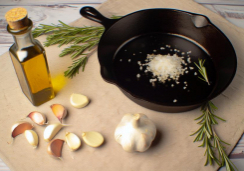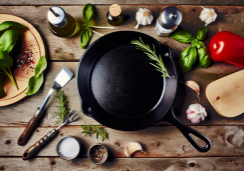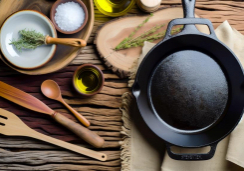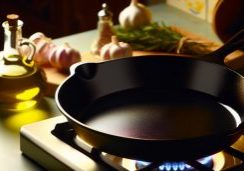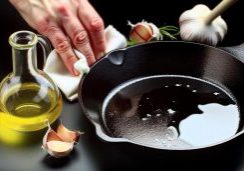Wok This Way: Beginner's Guide to Healthy Stir-Frying
Imagine your kitchen as a stage, and the wok as your instrument, ready to orchestrate a symphony of sizzling flavors and vibrant textures.
As you embark on the culinary journey of stir-frying, you'll discover that mastering this ancient technique is about simplicity and speed, but also about the subtle art of balance.
You'll learn to select the perfect wok, to prepare your ingredients with efficiency, and to wield your spatula with confidence, ensuring your vegetables are crisp, your meats are tender, and every dish is imbued with the right amount of fiery essence.
But before you can transform your ingredients into a harmonious medley, you must first understand the foundational elements that turn a simple stir-fry into a healthy feast.
Stay with me as we explore the secrets that lie within the walls of the wok, secrets that promise to elevate your home cooking to new heights.
Selecting Your Wok
When you're ready to dive into the art of stir-frying, choosing the right wok is crucial—it's the cornerstone of creating authentic and delicious dishes. Imagine a wok that flawlessly conducts high heat, ensuring your ingredients sizzle and sing the moment they hit the surface. This is where carbon steel becomes your culinary ally.
Renowned for its robustness, this metal retains heat superbly, allowing you to sear meats and vegetables to perfection.
A well-seasoned wok is a treasure in Chinese cooking. It's not just about flavor; it's about cultivating a non-stick patina that builds with each use. Round-bottomed woks are traditional and loved for their efficient heat distribution. They hug the flames, letting the heat climb up the sides, so you can push cooked ingredients up while the raw ones stay at the center, cooking evenly and quickly.
Don't forget the accessories—a wooden-handled wok spatula becomes an extension of your hand, deftly flipping and stirring. And a wok ring? It's indispensable for stabilizing your vessel on the stove. Get these right, and you're on your way to stir-frying with the finesse of a pro, making Grace Young's 'Stir-Frying to the Sky's Edge' your new kitchen bible.
Prepping Ingredients Efficiently
Before firing up your wok, take a moment to meticulously prep your ingredients, ensuring everything is cut, measured, and within arm's reach to facilitate a seamless stir-frying experience. This method of cooking is swift, and your stir-fries depend on having everything you need ready to go.
Slice your veggies into small chunks or thin strips; they'll cook quickly and evenly. Meats should be cut against the grain into bite-sized pieces, perfect for rapid cooking and easy eating. Marinating your meats ahead of time infuses them with flavor and tenderizes tougher cuts.
Remember, ingredients that take longer to cook, like carrots or broccoli, can be par-boiled or steamed in advance. Prepping ingredients efficiently isn't just about cutting; it's about strategizing the cooking order to achieve that delightful crunch-tender texture stir-fries are known for.
Keep your workspace clean and organized, with a dedicated spot for each prepped item. Have your oils, sauces, and seasonings measured and arranged in the order they'll be used. This prep work ensures that, once the wok is hot, you're not scrambling for soy sauce or searching for sugar. Instead, you'll be wokking your way to a fabulous, fast, and fuss-free meal.
Mastering the Stir-Fry Technique
To master the art of stir-frying, you'll need to embrace the dance of high heat and quick movement, ensuring each ingredient melds together in a symphony of flavors and textures. The seasoned wok is your instrument, and achieving 'wok hei,' that coveted smoky essence, is your goal. It takes more than just tossing ingredients into the pan—stir-fry technique is an art form.
The key is in the preparation: marinate your meats and have your veggies chopped and ready to go. When you heat up your wok, you're not just cooking; you're performing. 'Stir-Frying to the Skys' isn't just an expression; it's about skillfully managing the heat and deftly flipping food with precision.
You'll learn the circular pulling motion of wok tossing, a technique that keeps your stir-fries vibrant and crisp.
Balancing Flavors and Textures
Achieving the perfect balance of sweet, salty, sour, and spicy flavors, coupled with a variety of textures, will transform your stir-fry from a simple dish to a culinary masterpiece. As you craft your stir-fries, remember that every ingredient can add flavor and character. A dash of soy sauce brings a salty depth, while a sprinkle of sugar adds a hint of sweetness. Don't shy away from a squeeze of lemon for a sour punch or a pinch of chili flakes to introduce some heat.
When it comes to textures, it's all about diversity. Imagine the satisfying crunch of fresh vegetables against the tenderness of marinated meats. Add in some chewy noodles or rice, and you've got an array of sensations for Cook and Eat to revel in with each bite. It's crucial to time your cooking to perfection—veggies should remain vibrant and crisp, while your protein back in the wok should be just cooked through, ensuring every piece is succulent and full-flavored.
And don't forget the finishing touches. Garnish with toasted nuts or fresh herbs to introduce an unexpected crunch or a pop of freshness. Even a zest of citrus can elevate your dish to new heights with much less effort than you might think.
Are there any specific tips for mastering healthy stir-frying as a beginner?
When just starting out, learning the simple healthy stirfry basics can make a big difference. Use a variety of colorful veggies, lean proteins, and minimal oil to keep it nutritious. Prepping ingredients ahead of time and cooking at high heat for a short time are essential tips for mastering healthy stir-frying.
Cleaning and Maintaining Your Wok
Now that you've mastered the art of balancing flavors and textures in your stir-fry, let's ensure your wok is well cared for to continue producing delicious meals.
Stir-frying in a wok demands not just skill in the kitchen but also commitment to cleaning and maintaining your workhorse. After savoring the last bite of your Chicken Stir-Fry, it's time to wash up. Make sure to use hot water and a soft sponge to gently cleanse the wok. Avoid abrasive tools—they're the nemesis of the seasoned surface you've worked hard to build.
Promptly drying your wok is just as crucial as the cooking process itself. Don't let rust make an unwelcome appearance—wipe down the wok, then place it over low heat on the stove to banish any lingering moisture. Once dry, a protective ritual awaits: adding oil. Coating the interior with a thin layer safeguards your seasoning, ensuring the next stir-fry is just as flavorful.
Steer clear of soap; its cleaning power comes at the cost of your wok's well-earned patina. When not in use, store your trusty companion in a dry haven. And on the off chance rust spots do emerge, arm yourself with steel wool, scrub away the intruder, and re-season.
Follow these cooking tips, and your wok will remain a faithful ally in your culinary adventures.
Conclusion
You've now mastered the stir-fry basics with 'Wok This Way!' Your wok is your partner in crafting vibrant, healthy dishes. Keep slicing and dicing with efficiency, and let the wok's sizzle guide your culinary dance.
Balance every flavor and texture, and treat your wok with care—it'll reward you with countless delicious meals. Stir-fry's a breeze, and you're the chef steering the gust!
Go on, keep wokking and rolling in your kitchen adventure!

